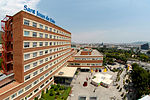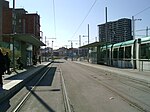Can Vidalet (Barcelona Metro)
Barcelona Metro line 5 stationsBarcelona Metro stations located undergroundBarcelona Metro stubsCatalan railway station stubsRailway stations in L'Hospitalet de Llobregat ... and 2 more
Railway stations opened in 1976Transport in Esplugues de Llobregat

Can Vidalet is a station on line 5 of the Barcelona Metro. The station is located underneath Carrer de la Maladeta, between Carrer de la Mina and Carrer Hortènsia in Esplugues de Llobregat and L'Hospitalet de Llobregat. It was opened in 1976. Originally and before 1982 was named 'Maladeta'. The side-platform station has a single ticket hall with two access: 1) career Hortènsia (built in 1976); 2) career Maladeta. The building of the second access (2010) had been long promised but the opinion of the affected neighbours was divided.
Excerpt from the Wikipedia article Can Vidalet (Barcelona Metro) (License: CC BY-SA 3.0, Authors, Images).Can Vidalet (Barcelona Metro)
Carrer de la Maladeta,
Geographical coordinates (GPS) Address Nearby Places Show on map
Geographical coordinates (GPS)
| Latitude | Longitude |
|---|---|
| N 41.371111111111 ° | E 2.0994444444444 ° |
Address
Carrer de la Maladeta
Carrer de la Maladeta
08906 (Districte V)
Catalonia, Spain
Open on Google Maps










